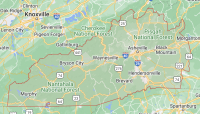Volunteer crews troll the forests to keep trails clear
Next time you hike a trail, pause a minute and give silent thanks to the legion of trail volunteers who have taken up arms and engaged in hand-to-hand combat with the forest, hacking back the undergrowth and clearing obstructive logs.
Volunteer trail crews devoted 28,000 hours of labor in North Carolina’s national forests last year. It often seems like an uphill battle, with the earth constantly trying to reclaim the zigzag of footpaths cut through mountains, but so far crews are holding their own.
“The trails, I think, are really in good shape,” said Mary Gollwitzer, a hiker in Haywood County.
Before Gollwitzer leads a hike for her club — known as the Leisure Hikers — she makes a practice of scouting the trail ahead of time.
“I don’t like to all of a sudden lead a hike and never have gone on it myself. I stay away from that because I don’t know what to expect,” Gollwitzer said.
She might revise the hike plan if the trail is too steep or has large boulders to scramble over, but she’s never ruled out a hike for the club because of maintenance issues.
Related Items
Volunteer trail crews make sure the cumulative mass of fallen limbs and downed trees don’t eventually overwhelm trails. They build back washed out bridges, repair eroding trail beds, fix soggy sections by diverting water from the trail, and cart out lots and lots of trash.
There are more than two dozen volunteer groups in the mountains that lend their sweat and muscle to take care of trails. The biggest is Carolina Mountain Club, which runs six volunteer trail crews that comb the mountains several times a week fixing problem spots on the trail.
“Our primary mission is to promote hiking in Western North Carolina, and of course, that means we need trails to hike on,” said Marcia Bromberg, president of Carolina Mountain Club.
Carolina Mountain Club logged 17,344 volunteer hours for trail maintenance in 2011, covering about 400 miles of trail.
Carolina Mountain Club is a stickler for detail when it comes to their trail work, approaching their maintenance reports with a level of notation and specificity you would expect from a NASA shuttle launch.
Some trail volunteers pack their handheld GPS unit, able to catalog the exact trouble spot.
“I observed a dead fall at E 36404, N 3946090 whose removal will require a later trip,” crew leader Wayne Steinmetz reported on a trail scouting trip.
Or, “I observed that ice covered the trail at E 365491, N 3946623 (WGS 83 horizontal datum).”
Their trail maintenance log from 2011 goes on like this — for 190 pages — detailing the who, what, when and how of more than 1,200 volunteer work outings held last year by their various trail crews.
“Hiked in from Sunburst on FS 97 and 97H. Cleared several simple downs, repaired tread at two wash locations and lopped rodies and beech sprouts along uphill side of trail,” Paul Dickens wrote in his report of a workday in the Middle Prong Wilderness in Haywood County last January.
Most trail reports are highly clinical in nature, but you can always tell when Becky Smucker’s come through. She can’t resist throwing in a line about the weather and her botanical findings of the day.
“We did a spring scout of Shining Creek Trail …We removed downs, lopped some, fixed some drainage, reworked one major tread problem, removed some fire rings and carried out a little trash. It was a gorgeous spring days, and giant Vasey’s trillium was in bloom,” Smucker wrote in one report from a workday near Cold Mountain in Haywood County last May.
Strength in numbers
Several volunteer trail groups have sprung up to take care of trails in a very specific area, such as Friends of Whiteside Mountain in Highlands, or of a particular trail, like the Bartram Trail Society or Benton MacKaye Trail Association.
One of these hyper-local groups is the Friends of Panthertown in the Cashiers area of Jackson County — a group united by their love for the place known as “Yosemite of the East.”
The idea of small-scale, local groups taking care of their own little slice of trails is a model the forest service would like to emulate in its quest to build a larger volunteer base, said Jason Kimenker, the director of Friends of Panthertown. The group, which numbers 350 members dedicated to the protection and preservation of Panthertown, has about three dozen trail volunteers who turn out for regular workdays.
In reality, a relatively minute percentage of hikers actually volunteer to work on trails. But adding more volunteers to the mix isn’t a simple solution, Bromberg said. Orchestrating trail crews is complicated and time consuming.
“There are various skill levels, everything from trained sawyers and people like me who go out with my loppers and that’s about the best that I’m going to be able to do,” Bromberg said.
While hikers constitute the vast majority of volunteers working on trails, mountain bikers have upped their presence considerably in recent years. Several mountain bike chapters hold regular trail workdays. They concentrate their efforts in popular mountain bike destinations, like Tsali, Bent Creek and DuPont State Forest.
Horseback groups have historically been the least represented in trail maintenance circles but have been pitching in more in recent years.
Where the forest service can’t keep up, “friends of various stripes have come in and taken a piece of the burden off them,” Bromberg said.
The Wilderness Society last year launched a trail crew to focus on maintenance specifically in national forest areas designated as “wilderness.” Wilderness areas are a challenge when it comes to trail maintenance because power tools aren’t allowed, which means no chainsaws.
The Southern Appalachian Wilderness Stewards uses a combination of volunteer and paid trail crews, with the help of a grant from the National Forest Foundation.
“It was birthed to take some of the pressure off the trail clubs, which found they couldn’t support more wilderness designations if they couldn’t take care of their trails,” said Brent Martin with The Wilderness Society’s Southern Appalachian field office in Sylva.









